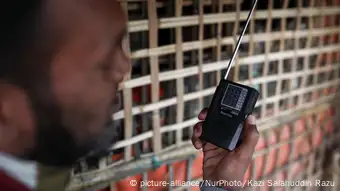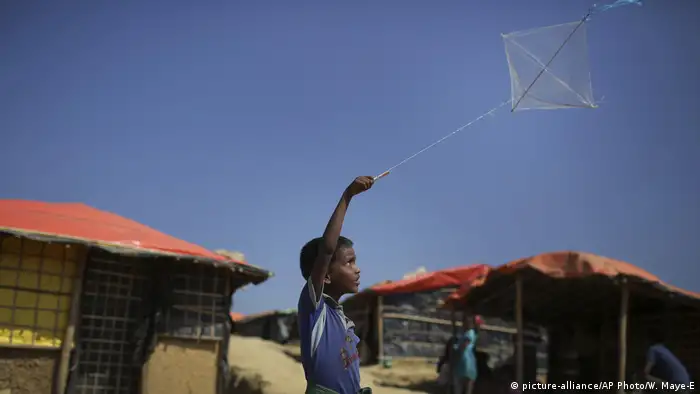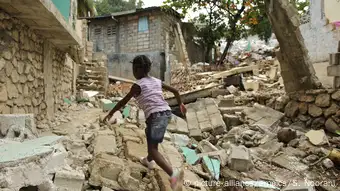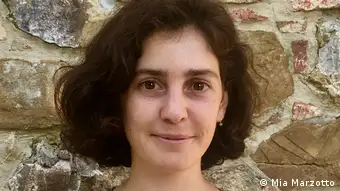Interview
The right kind of words
In emergencies, information saves lives. But language barriers can block aid efforts, leaving people at risk. On World Refugee Day, Translators without Borders’ Mia Marzotto explains how to overcome those challenges.
#mediadev: Mrs. Marzotto, you supported crisis response teams in Bangladesh, Nigeria, Mozambique, or the Democratic Republic of the Congo. Why is language important in humanitarian aid delivery?
Mia Marzotto: It is important to recognize that humanitarian aid is not only about food, water, or shelter. It is also about listening to people and ensuring they have access to the information they need to be safe and well. Language comes into play as the foundation upon which communication happens. Listening and understanding people's own definitions of their problems and their priorities builds on local knowledge and avoids reinventing the wheel or bringing in approaches that are completely irrelevant to the context.
If we fail to consider language, it becomes a barrier to inclusion. Most of the countries that face humanitarian emergencies are linguistically diverse. Sticking to the official or dominant languages excludes large sections of society. And these groups are often already at higher risk of exclusion in other ways; groups such as women, older people, and people with disabilities. It diminishes the impact that humanitarian aid can have. We have always made a lot of assumptions about language, [believing that] working with local colleagues or having a term for a specific issue in English, when translated, would immediately clear these barriers. But this is often not the case.
Could you describe a specific situation?
A pivotal moment was the 2010 earthquake in Haiti, where the international humanitarian aid community assumed French would be enough to manage the response. However, very few people in Haiti speak French, where Haitian Creole is the main language. It clearly showed the need to address language barriers in real time and in a crisis.
The COVID-19 pandemic is putting language and communication in the spotlight, where we all recognize that for the response to be as effective as it needs to be, there needs to be effective communication. And effective communication hinges on making sure that people understand and can communicate in both directions.
How do you ensure people understand you in a crisis situation?
There are different factors, languages being one of them. Literacy levels and the format in which communication happens also play a role. As an organization, Translators without Borders is always advocating to work with the most diverse types of formats possible and to follow the plain language principles. This follows the objective of making sure that people understand by putting the audience first and using the right kind of words. Avoiding technical jargon and all those acronyms.
Besides that, working through trusted sources of information is also important, such as local community radio stations. Lastly, communication needs to be as responsive as possible. You need to answer people's questions and engage with them on their concerns, where the language and the choice of words are crucial.
You mentioned that also two-way communication is necessary to maximize humanitarian aid efforts. How do you guarantee communication happens in both ways?
At Translators without Borders, we start with doing a lot of sociolinguistic research and understanding what languages and terms people use. For example, we produce glossaries, lists of commonly used or technical terms in relation to specific issues or specific responses. We identify appropriate translations of those terms in the relevant local languages with input from native speakers or from community members. It also unearths a lot of communication difficulties.
For example, in the Rohingya refugee camps in Bangladesh we have developed a glossary related to COVID-19 and found that men understood the words for “epidemic” in Rohingya (aba biaram and gorom biaram), but women understood them to mean “diarrhea,” which of course is very different. So in developing these kinds of tools we are not only able to see what people's understanding is of specific terminology, but also what some of the issues can be. We use that to provide translation support for our partners and help make sure people have access to clear, useful information they understand.
How can you reach isolated communities with underserved languages?
We work through a community of more than 30,000 volunteer translators, who are often from these communities, either on site or as diaspora members. We also try as much as possible to support partners with already established links. Not just the big organizations like UN agencies and international NGOs, but also smaller local organizations. We also prioritize work in different formats like audio and video and support multilingual data collection through different channels.
For instance, together with Internews, at the height of the refugee response in Greece in 2015, we were monitoring the multilingual social media posts of refugees and migrants. This was to identify misinformation or rumors that were spreading and then use this as a basis to share factual information and addressing rumors in their languages. And we use language technology to increase the speed and reach of our work.
What role would media play in overcoming language barriers?

A Rohingya gets information from Myanmar Radio using his radio in the Balukhali refugee camp in Bangladesh (2019)
Perhaps there are two sides to that question. One is local media, which is usually a critical source of information to and from communities. Local media can help disseminate information in local languages in different formats, engage with trusted community leaders and discern specific needs. Community radio stations are a perfect example of that. In our experience, local media might also face difficulties with multilingual communication and need language support.
I was recently in Goma, in the Democratic Republic of the Congo, as part of Translators without Borders’ Ebola response where we organized language awareness building sessions with Congolese reporters. One of these sessions was around terminology and the challenges of dealing with medical terms in French, even though the local population speaks mostly Congolese Swahili and Nande among other local languages. The intermediary role reporters have to play, sometimes without preparation or health background, is complex without language support.
The other side would be global media, which can help to shed light on global language barriers. Media outlets can help build understanding for language diversity and the need to build language support into humanitarian responses.
How do aid efforts need to change to ensure language gaps are addressed effectively?
There are various steps. Linking back to assumptions, which create language barriers, a very important first step is replacing those with data. We do not collect data systematically about the languages people speak and their communication needs. Collecting that data could really help in building communication strategies and making funding and programming decisions based on evidence.
It is great to see different organizations being more aware and addressing language barriers in their own capacities. However, for very marginalized language communities and low resource languages, it does not necessarily make sense to do it one organization at a time. It is a lot more effective to be doing it across efforts so that multilingual communication can be accessed by all. We base our programs on this common service model, with language support across the board.
Capitalizing on the potential of language technology is another angle which we are working on. More can definitely be done, with the potential to make multilingual communication more efficient, more consistent, and more two-way.
On the occasion of World Refugee Day, is there anything else, which you would like to give us to take along?
As a general point, for people who work in humanitarian organizations and in different languages, navigating these communication issues is an obvious part of our everyday life and interactions. But for refugees and other people in crisis situations, overcoming language barriers could make a difference between an informed decision and being lost, not knowing what assistance is out there. It can even mean the difference between life and death.
The simple saying “lost in translation” or “lost without translation” could use a little bit of perspective, and we need to understand that language is about so much more than translation: it is about dignity, empowerment, and pride in your own culture. We all can definitely relate to it, but we sometimes forget these basics.
Mia Marzotto is Senior Advocacy Officer at Translators without Borders. Prior to joining Translators without Borders in 2017, she worked with Oxfam on media and advocacy in the Palestinian Territories and Israel, as well as around the refugee response in Italy.
Interview: Gerwin De Roy
DW recommends
- Date 19.06.2020
- Feedback: Send us your feedback.
- Print Print this page
- Permalink https://p.dw.com/p/3e2SP
- Date 19.06.2020
- Send us your feedback.
- Print Print this page
- Permalink https://p.dw.com/p/3e2SP



